Southwest Chief

| Route 66 | Cities | Beaches |
|
Southwest Chief |
 |
Southwest Chief |
Sunset Limited |
Palmetto |
Crescent |
VIA |
Because for most of its history the Southwest Chief (first known as Chief, then Super Chief) stopped at Pasadena and was the favorite route of celebrities, it was known as The Route of Stars. More often, it was referred to as The Grand Canyon Route, since it not only stopped at the Grand Canyon but actually built the El Tovar Hotel on the South Rim. It's still Amtrak's most glamorous run. It passes wheat fields and cattle ranches, Native American Reservations, National Parks, high mountain passes, deep canyons, most of Route 66, the Mojave Desert, the Petrified Forest, the nation's hottest town (Needles), and some of the nation's lushest farmlands. The SW Chief has the same equipment as other Amtrak long distance routes : coach cars, sleeper cars, dining car, observation car, baggage/mail car and two diesel engines. It leaves Chicago on the same track, stopping at the same three Illinois towns, as the Zephyr. If you want to read aboiut those towns, go to the Zephyr page. Once it crosses the Mississippi, it turns southward away from the Zephyr. |
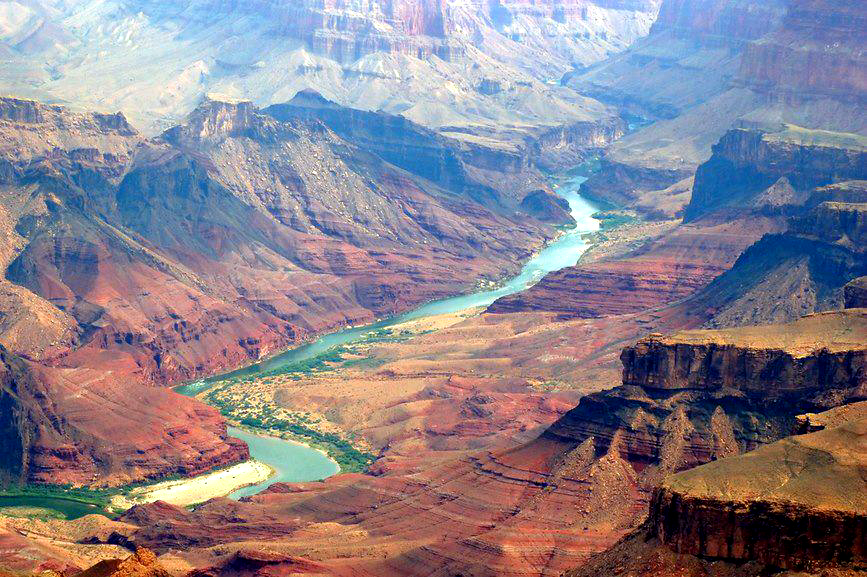 |
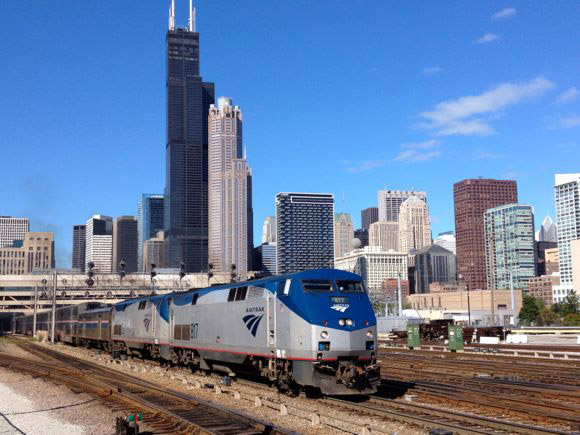 |
The Texas Eagle follows Route 66 down through Illinois and across Missouri before dropping into Arkansas. The Chief picks Route 66 up at Albuquerque and follows it all the way to Los Angeles. The train is actually slower now than it was back in its glory days in the 1940s and 1950s. Back then it made the run in 36 hours. Now it takes 41 hours. This is because two segments of track can no longer be used. The first was the Pasadena segment. It was totally destroyed by an earthquake. Amtrak now uses trackage further south, no longer serving Pasadena. The second segment is the old route across Kansas. Officials at BNSF no longer maintain that trackage at a level required for passenger trains, and Congress refuses to allocate the money needed for Amtrak to restore it to its prior condition. The newer segment takes longer. The Santa Fe also took great pride in the Chief and cleared the tracks for it, using the 36 hour time as a bragging point. Today, the BNSF gives freight trains priority and the Chief has to pull onto sidings several times to wait for freights to pass by. |
Like all Amtrak long distance runs, the Chief offers both roomettes and deluxe sleeping compartments. The deluxe rooms (photo, right) feature a larger bed on the bottom which could be used by a married couple while a child slept on the top bunk. The deluxe also has a sink, toilet and small shower in the room, although the communal shower downstairs is bigger. Like the romette, the deluxe has seats by the window, reading lights, AC plugs for charging electronics, a radio for music and a small table which folds out for playing chess or sitting a computer on for work. If only a couple were using the deluxe, it would have the advantage that they could use the top bunk for luggage and not have to store their bags downstairs. The problem is the deluxe costs more than two roomettes so it's not a way to save money. It does, however, make the trip a lot more comfortable. |
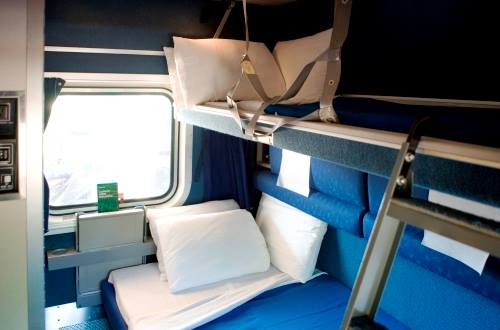 |
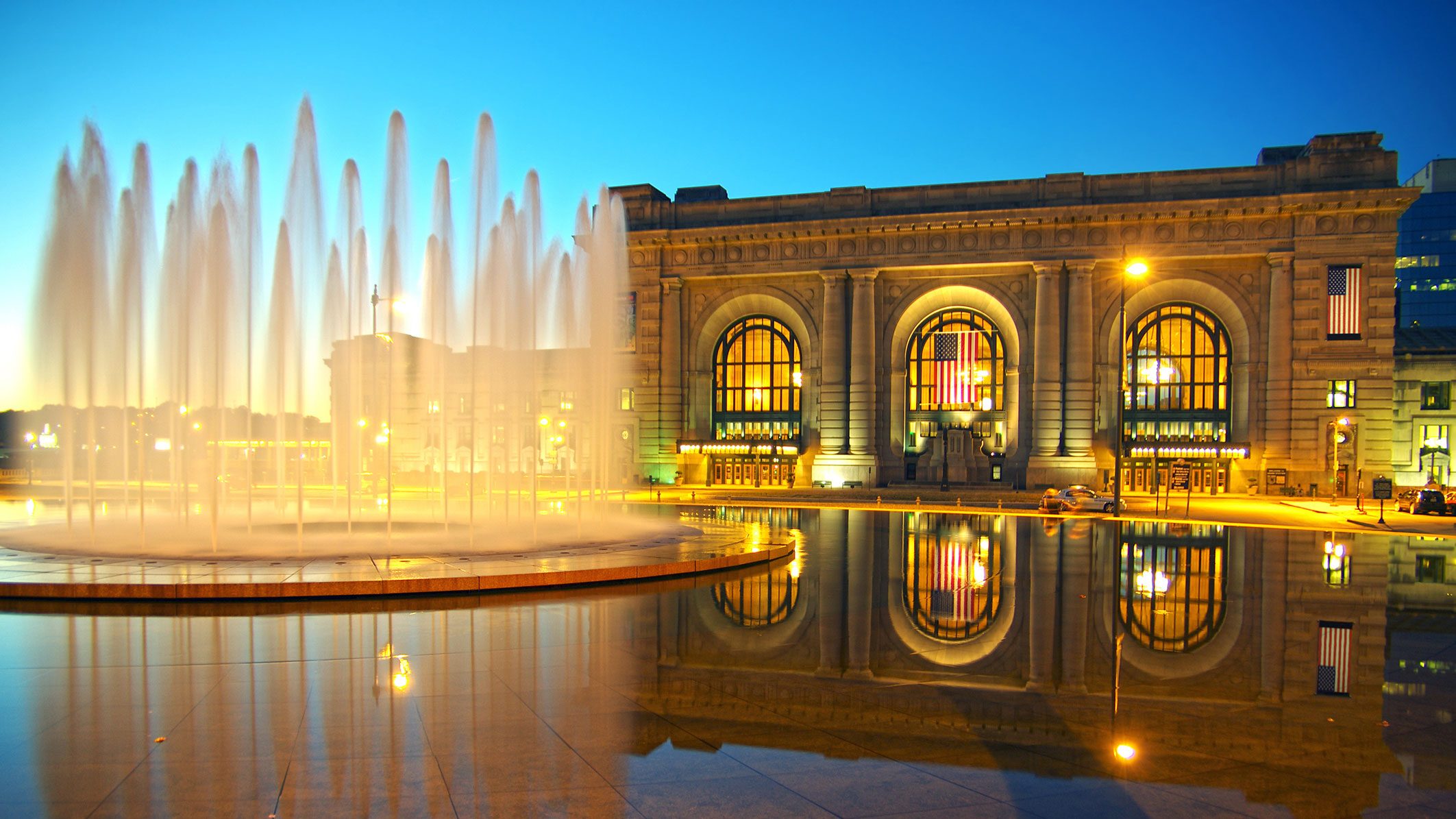 |
You'll be eating dinner while the Chief crosses Missouri. The farms are raising mostly corn and soybeans although you'll see the occasional herd of cattle or groups of hogs or chickens. If you ride both the Zephyr and Chief you'll notice right away Missouri farmland is not as rich as the Iowa farmland just north of it. The Chief pulls into Kansas City Station at 10 pm for a 40 minute servicing stop. You really should get out and walk around. This is one of America's nicer stations. The trains pull into the rear, but the front looks like the photo at left. Unfortunately you'll be in darkness all the way across Kansas. You'll be waking up just as the train crosses the state line into Colorado. This is a shame because Kansas is a beautiful state. The eastern third is traditional farming and the middle third is mostly wheat before cattle ranches take over in the western third. |
The Chief angles across southeastern Colorado through the Commanche National Grasslands. It stops at the only three towns in this corner of the state : Lamar, Lajunta, and Trinidad. "Grasslands" might sound like a wide expanse of flat pasture, but in fact the terrain is kind of interesting. Bring a pair of binoculars and you can spot quite a bit of wildlife out here. It includes Antelope, Mule Deer, Prairie Dogs, Elk, Wild Turkey, Fox, Wolves, Roadrunners, Prairie Chickens and 328 species of birds. This is considered one of Colorado's finest birding sites. Apache and Commanche both inhabited this land. Petroglyphs, teepee rings and fire pits date back 8,000 years. Some of the world's finest dinosaur tracks can be seen here, especially Brontosaurus and Allosaurus. During the Summers rangers lead publlic tours to the tracks and the petroglyphs. During the Spring and Fall there's good hiking and backpacking here. |
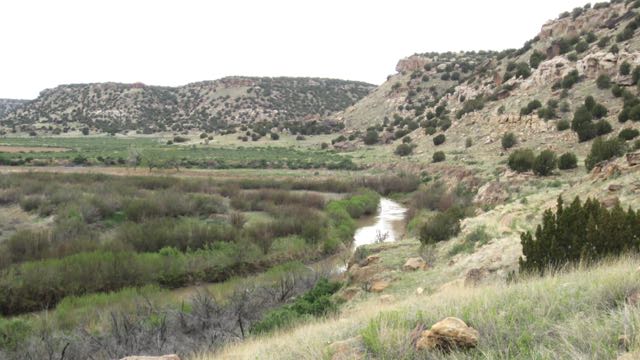 |
 |
From Trinidad, the Chief begins climbing. At the Colorado-New Mexico state line it will cross historic Raton Pass at 7856 feet. The state line is just a few yards north of the northern tunnel portal. The pass was a major passageway for early wagon trains carrying settlers into New Mexico and Arizona on the Santa Fe Trail. The railroad laid the tracks and dug the tunnel in the 1800s and this was the main rail route for 100 years. But the grade is steep, and the BNSF finally laid new track to bypass Raton. Today, the Chief is the only train using it. But that is a problem. With the BNSF not using the track, it is no longer maintaining it. Temporarily, Colorado and New Mexico are contributing funds to keep the track open until hopefully Congress will decide to fund it. |
Raton is one of the more interesting stops on the trip. This is the stop for Philmont Boy Scout Camp. Since 1941, Boy Scouts from across the nation have come to Philmont, and for those in the Midwest and further East, the Chief is how they get here. Shuttles take them from Raton to Philmont. Several hundred Boy Scouts a week get off the Chief at Raton, while several hundred more get back on after their visit. While on board, most Scouts save money by travelling in Coach, and Amtrak uses extra coaches in June-July-August to accommodate them. Amtrak also puts on extra employees at Raton during those months to help the Scouts unload quickly and load the shuttles. When the track over Raton Pass was in danger of being discontinued, all over the Midwest and Northeast several hundred thousand Scouts, their parents, Scoutmasters and administrators wrote, emailed and called Congressmen and other officials urging them to fund its continued maintenance. Many were adults in key positions who had once been Scouts and come to Philmont. Amtrak officials have always relied on railfan groups like the National Rail Passengers Association to keep the pressure on Congress, but they were stunned by the size and intensity of the Boy Scout response. It kay have saved the Southwest Chief. |
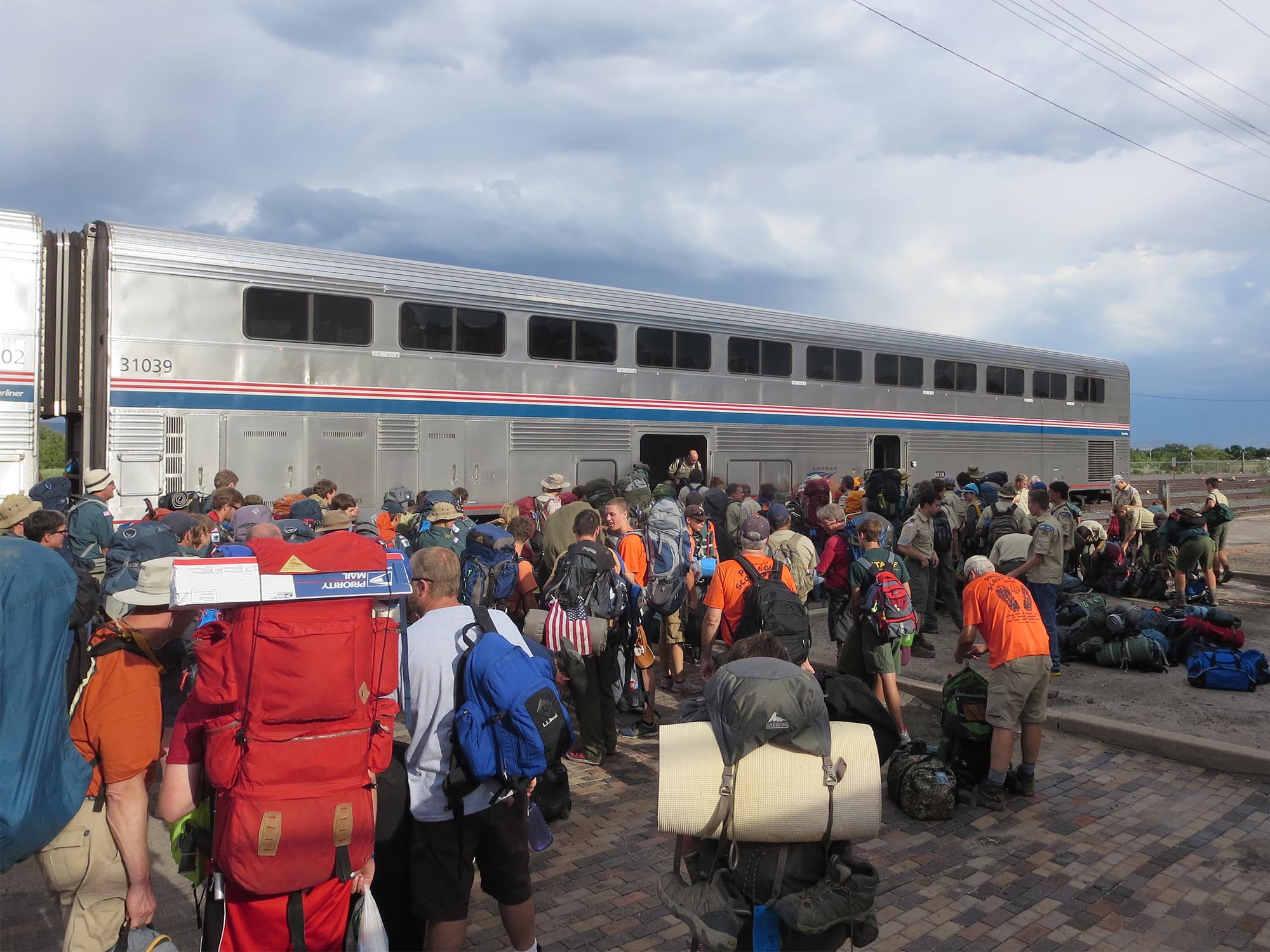 |
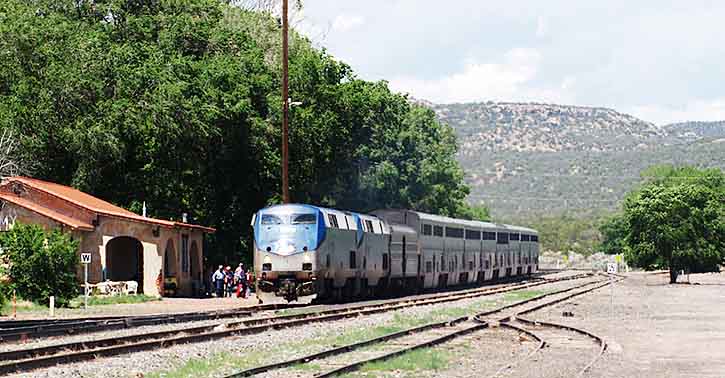 |
At 2:00 you'll stop at Lamy, the Amtrak station for Santa Fe. There's a shuttle or you could rent a car. If you were ever to consider a one day stopover on an Amtrak trip, this would be the place. Santa Fe is definitely worth 24 hours, if not a week. This is an especially wonderful stopover if you're arriving on Friday or Monday, since the incredible Mexican Open Market is open Tuesdays and Saturdays. It's a beautiful very old Spanish town, established well before the Mayflower arrived in Massachusetts. It has retained most of its orginal Spanish architecture and flavor, including some great hotels, great missions, and that great Mexican open market. The Chief stops at Lamy station at 2:00, so you could get off , spend the rest of the day and evening in Santa Fe, spend the next morning at the Market before returning to the Lamy station. If you arrive on a Saturday, it would be worth the stopover for the Artisans Market Sunday morning. The eastward Chief stops at Lamy at 1:00 pm. |
| If you were to stop over in Santa Fe, we recommend the The La Fonda Hotel. 800-523-5002. When the Spanish founded Santa Fe in 1607, they built La Fonda, or The Inn. The Santa Fe Trail ended here, and through the 1700s and 1800s trappers, soldiers, cattlemen, prospectors, businessmen and politicians mention in letters, diaries and journals staying at La Fonda. The hotel in 1925 was bought by the Santa Fe Railroad and turned over to Fred Harvey. In 1968 Sam Ballen bought it and the Ballen family still runs it. Staying here is quite an experience. You're right on the square. The La Fonda itself contains shops and restaurants, and up and down the street are a hundred more. La Plazuela Restaurant specializes in New Mexico cuisine, and La Fiesta Lounge offers a daily lunch buffet. |  |
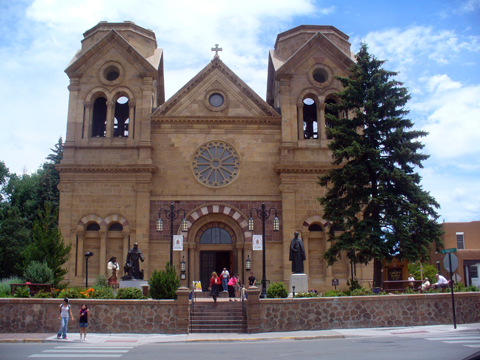 |
In downtown Santa Fe, you'll see this magnificent Cathedral Basilica of St. Francis of Assisi on the square. It's definitely worth a stop. If you stay at La Fonda this will be just down the street. Begun in 1869 and completed in 1886, the cathedral contains numerous statues and other features of special note. The large rose window in front and the stained glass windows along the sides commemorating the 12 Apostles were imported from France. The doors are of Bronze, the baptismal font of Granite, and the Stations of the Cross in etched glass. These are the earliest examples of etched glass in North America. This is the largest cathedral in New Mexico, and is not a historical display. It is not only a functioning church, but is the mother church of the Archdiocese of Santa Fe. You don't have to be Catholic to appreciate this building. The ceilings, sculptures, stained glass, and various historic artifacts are museum quality. |
You haven't seen a Farmers Market until you've seen the one in Santa Fe. You can buy Blue Corn, Bolita Beans, Posole, Mesquite Cactus Honey, Buffalo Sausage; Ancho, Guajillo, Habanero and other Chiles; Dairy products, especially Cheeses; local Wines, Tomatoes you've never heard of like Oaxaca, Purple Swash and Rose Quartz; Various kinds of Jerkies; and Jujubes ("Desert Fruit"). Jujubes are like red dates. You can buy Tomatillos and Native American rugs, blankets, pottery, baskets and art. The Baked Goods are unique : you really MUST try the Green Chile Croissant. There are also food vendors, tempting you with local entrees like Poblano Chile Stew, Grilled Lamb Skewers and Navajo Goat Cheese. Every Saturday and Tuesday from sunrise until noon. There's also the Railyard Artisans Market from 10 - 4 every Sunday. It features hand blown glass, jewelry, pottery, paintings, fiber art and sculpture.
|
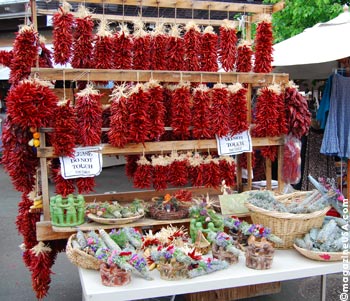 |
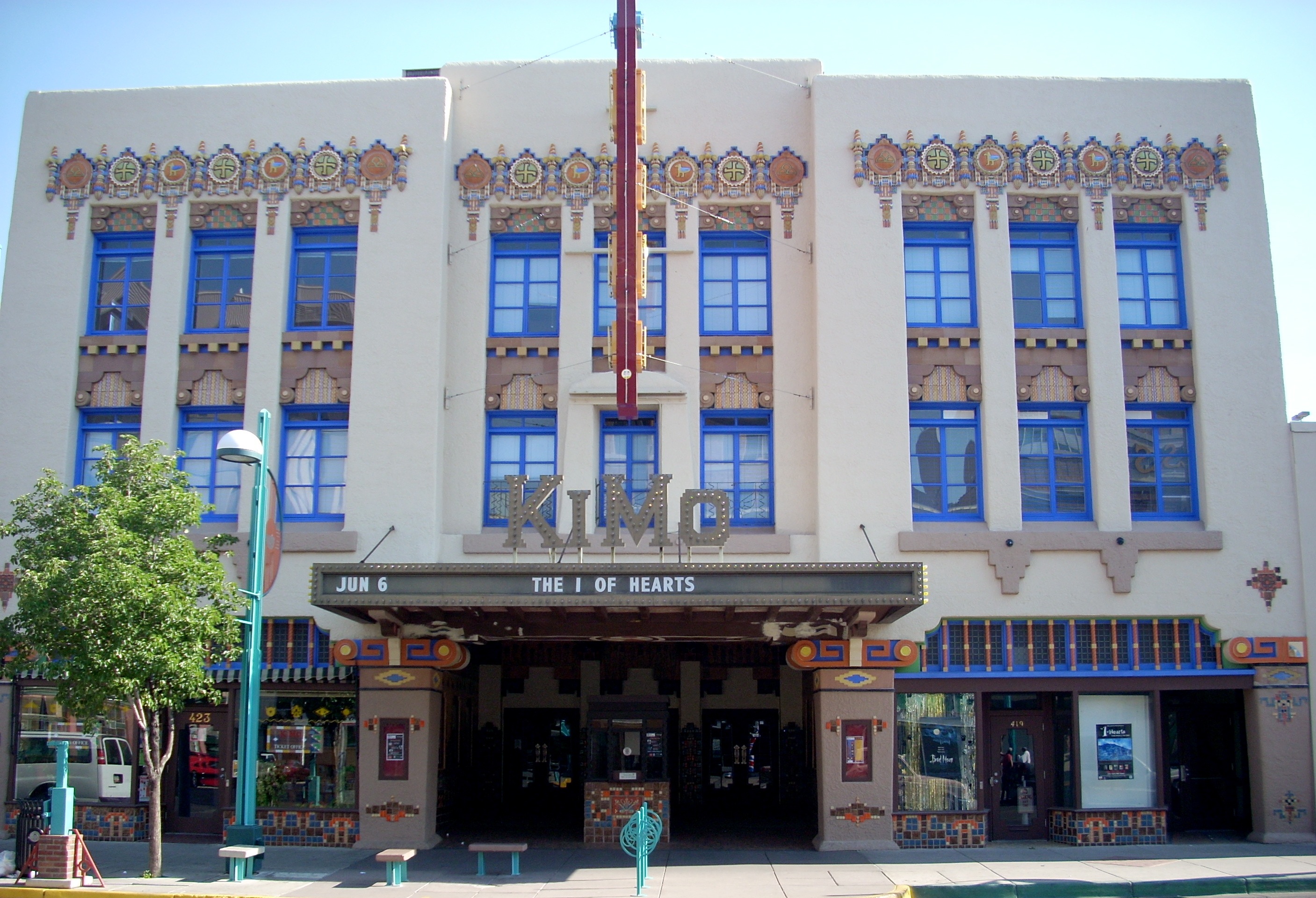 |
Leaving Lamy, you'll wind through mountains and forests, including steep climbs and tight turns, finally stopping at Albuquerqe at 3:30. This is a major 50 minute service stop, so you have time for a four block walk to the Kimo Theatre, built in 1927 and the greatest example in the nation of the Pueblo Deco architectural style. Architect Carl Boller researched Pueblo architecture thoroughly before picking up his pen, and the building shows all the classic Pueblo devices : rounded corners, cumulative massing, use of colors and shields, double recessed windows and doors, etc. The Kimo is still a working theatre with major films, concerts, plays and speaking engagements. The interior looks like a traditional Kiva, with log ceiling beams, dance and hunting scenes, Navajo rugs, and drums. Wrought iron birds and buffalo skulls decorate the staircases. The Kimo is open from 9 to 4 five days a week for visitors and is open for performances in the evenings. They'll close at 4, so you'll have time to hurry back to the Albuquerque Station, itself a work of art inside and outside. |
From Albuquerque, you'll set off on a two and a half hour cruise across the high desert. Far from boring, this can be an exciting early evening. There are lots of fascinating animals and sights to see. The first is the Road Runner. It's a long legged bird found only in the deserts of Texas and New Mexico with a few in Arizona. For their entertainment, Road Runners like to race cars and trains. They'll see you coming and wheel in from out on the desert, then speed up to match whatever you're doing. If you speed up, they'll speed up. If you slow down, they'll slow down. They'll run along with you for a mile or so, then veer off onto the desert as they reach the end of their territory. After a few miles, another one will join you. At top speed, just like in the cartoon, their legs are revolving so fast they're only a blur. Roadrunners are actually Cuckoos. They don't fly well but outrun their prey. They're omnivorous, eating anything from insects to spiders to lizards to snakes. They nest inside Cacti and mate for life. Marathon, Texas has a giant statue of a Road Runner and many high school sports teams in the Southwest are named for them. |
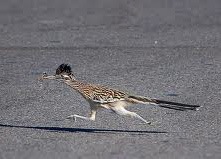 |
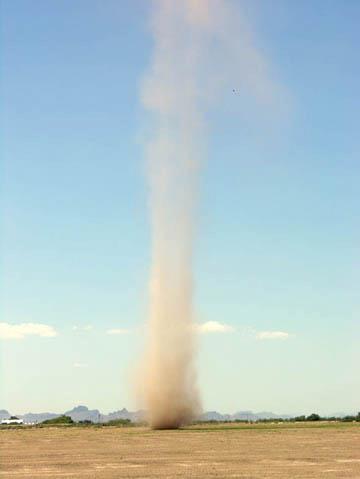 |
One of the fascinating features of the Southwest landscape is the Dust Devil. Sort of like miniature tornadoes, they occur as the intense heat interacts with air currents. You'll see one out in the distance, racing across the desert, looking rather frightening. But they suddenly just dissolve. They pick up sand, dust and dirt and can extend for a hundred feet or more in the air. Usually, when conditions are right for one to form, you'll see a bunch, each one arising as the one preceding it dissolves. Dust Devils are most common in late afternoon and early evening due to the intense heat which built up during the earlier afternoon. |
| As you pull into Gallup at 6:45, watch out the south windows for the El Rancho Lodge. It's before you reach the Amtrak Station. The El Rancho is one of America's great Hollywood landmarks. R. E. Griffith built it on the high desert in 1937 to host Hollywood stars filming Westerns. His brother, famous director/producer D. W. Griffith, filmed here and other studios followed. Errol Flynn, Clark Gable, John Wayne, William Holden, Roy Rogers, Gene Autrey, and every other major Western actor, including Ronald Reagan, stayed at El Rancho, all arriving on The Chief. They were a demanding clientele, and the hotel, bar, rooms and services were elite. But Westerns lost popularity and Hollywood moved to other locations. The town of Gallup grew up around El Rancho, so it lost its isolated desert ambience. The hotel has changed ownership several times, and it's showing its age. Services are adequate but no longer elite. The hotel is overdue for renovation. Still, if you're driving Route 66 or I-40, it's worth a stay. Rooms are spacious with flat screen TVs and free WiFi. Bathrooms are small and there are few plugs. The lobby is still beautiful with its huge stone fireplace. The restaurant and bar are still very well run. The food is good at reasonable prices. You can spend hours wandering the halls and lobby looking at three thousand photographs of famous guests. Notice the beautiful Amtrak Station --- It was built in 1937 when there was no town, just the El Rancho. | 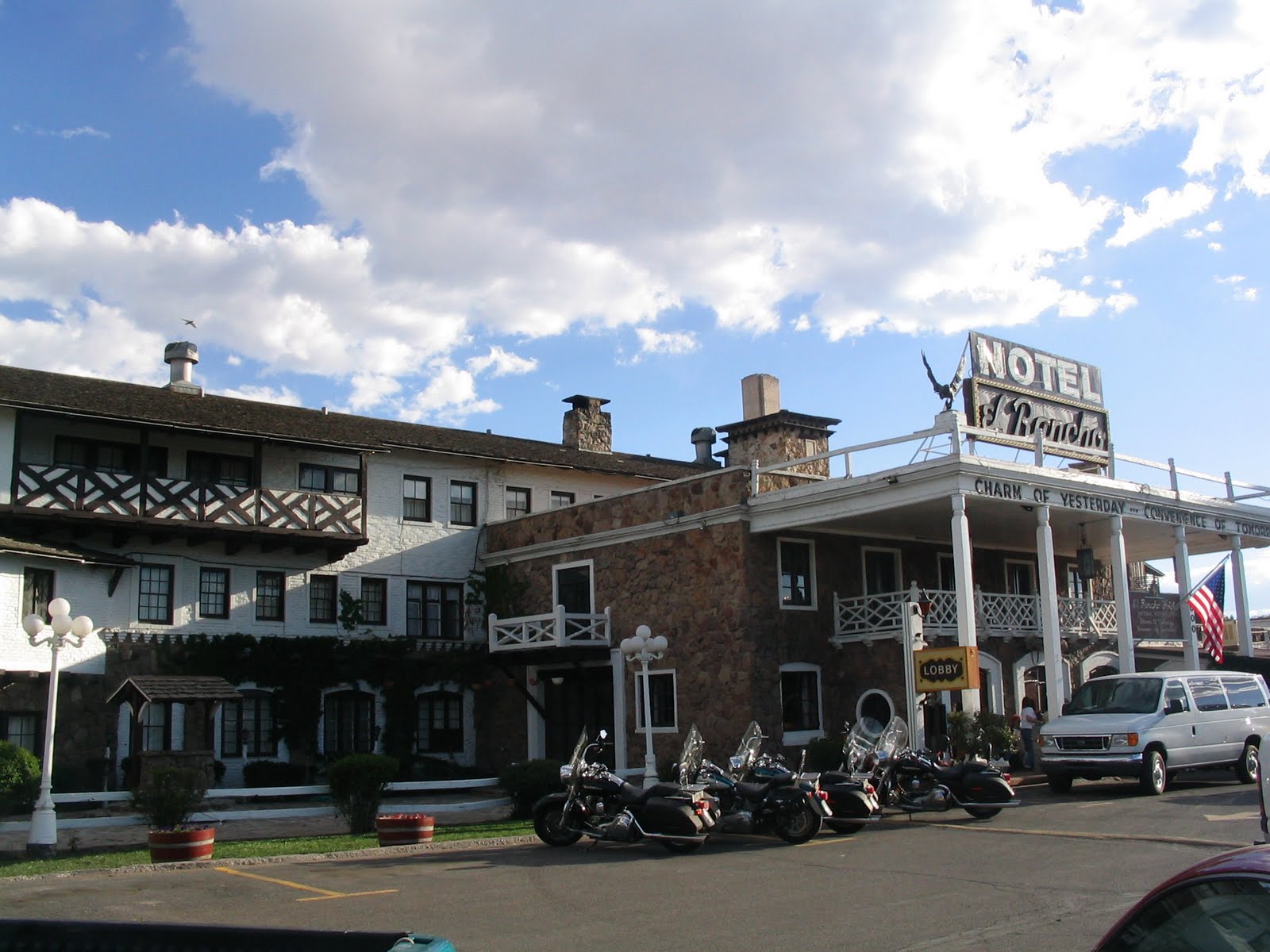 |
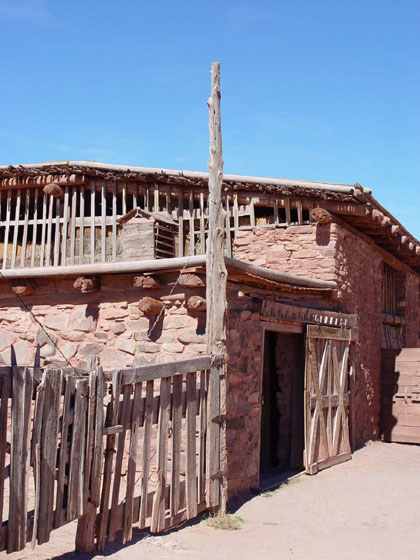 |
As you enter Arizona you'll be passing through the Navajo and Hopi Reservations. Just to the north is the famous Hubbell Trading Post. This is not a replica or a reenactment; it's the original trading post in its third century of business. It is the oldest continuously operating trading post in North America. Today, the post serves residents of the Navajo, Hopi, Zuni, Apache and Comanche nations. Navajo weavers create rugs at the trading post and you can buy what they make. The site includes more than a large store. There is a 130 acre homestead, featuring a home and outbuildings. Today, there's a display of Native American art. For 100 years, Hubbell maintained a guest house for white visitors and a row of Hogans for Native Americans who came from far away. Today, however, there is neither lodging nor restaurant at the trading post. During the 1800s and the first part of the 1900s, no money was used here. Hubbell would bring goods from back East, especially coffee, sugar, tools, flour, baking powder, tobacco and, later, canned goods. When the railroad reached the Southwest he would pick up wagonloads of goods from the depot in Gallup. The Native Americans would bring wool, blankets, rugs, jewelry, pots, and baskets. Gallup would take these in exchange, then sell them to buyers from back East. The Hubbells were unique in that the whole family lived here. Other trading posts were run by men who kept their families back East. Several generations of Hubbells are buried here in the family cemetery.
|
| The Chief trsvels right through Petrified Forest National Park, and you can get several spectacular views. This is an amazing park, where you pass through huge fields of long ago trees now turned to stone and preserved. (A sad sidelight to a visit here is you learn about how people carted off specimens by the trainload and continue to haul away whatever they can sneak out in their cars, trucks or pockets. So spectacular as it is, what we see today is only the leftovers from a century of looting.) | 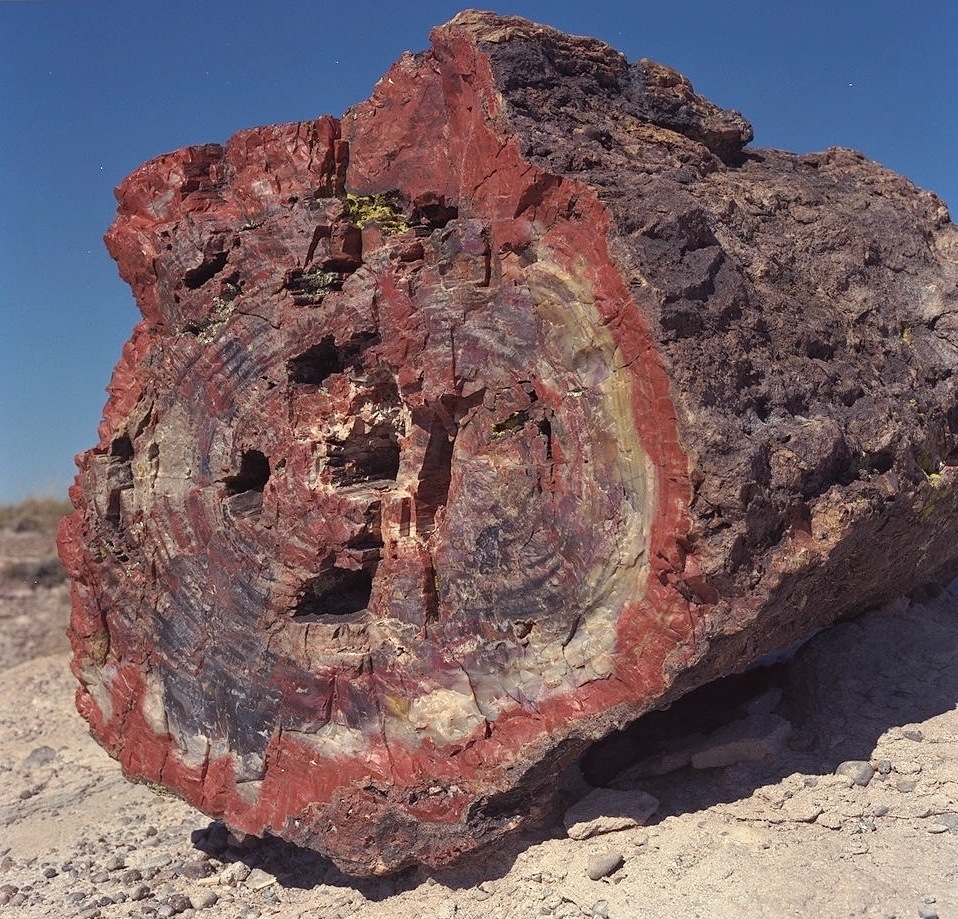 |
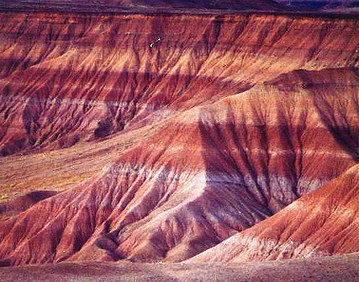 |
The Painted Desert is a spectacular and intensely photogenic area. You'll see only a small part of this 95,000 acre landscape as the tracks skirt the southern edge. The Painted Desert extends roughly from the Grand Canyon to the Petrified Forest, with much of it laying in the Navajo Nation. You'll need to be sitting at a north facing window to catch glimpses. |
Just as you pull out of the Holbrook Amtrak Station, look out a north facing window at the Wigwam Village Motel, Holbrook. This is the most famous of all the vintage Route 66 motels. You sleep in a concrete wigwam. It's pretty snug inside, with a tiny bathroom and a sloping ceiling. The location is certainly appropriate, surrounded by Petrified Forest National Park, the Navajo, Zuni and Apache Reservations, Hubbell Trading Post and Fort Apache. The wigwams have gas heat, air conditioning and TV. Beds are comfortable, with firm mattresses and soft warm Indian blankets. The staff is friendly and efficient and there's a small Route 66 museum and gift shop in the lobby. There were originally seven of these Wigwam Village Motels, but only three remain. The first two were built in 1937 and 1938, before World War II, and included a swastika as part of the Native American art etched into the outside of each teepee. The swastika had been used in Navajo sand paintings for thousands of years. After Adolf Hitler and the Naziis adopted the swastika as their symbol, it was removed from the existing Wigwam Villages and never used in these 1950 teepees. |
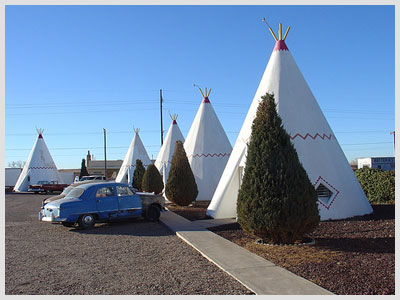 |
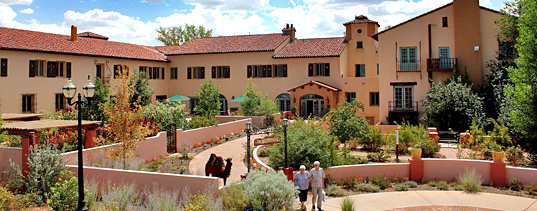 |
Winslow is the most amazing Amtrak Station in America. It's a full scale resort, La Posada. The Southwest Chief stops here twice a day. Behind only Santa Fe, this would be the second best Amtrak layover in the U.S. The finest restaurant in Arizona and one of the finest in the nation is the Turqouise Room here. The Native American Stew and Chilliquilles are their signature dishes but the entire menu is exquisite. Rooms here are very nice. The song "Standing on the corner in Winslow Arizona" made the town famous and 100,000 people a year stop by the main intersection to have their pictures taken. This would be a good base for a several day visit to the Petrified Forest, Navajo Reservation, Meteor Crater, Grand Canyon and Monument Valley. You stop here at 8:30 pm. |
| Possibly the most stunning stop along the Chief's run is Meteor Crater. Watch for the upraised rim south of the tracks out a south facing window, just before the tracks pass under I-40 about five miles west of Winslow. The meteor that smashed into the Earth here did so with such speed and power it sank deep below the surface while throwing up the huge crater and hurling debris across the desert for miles. Scientists have been researching the site ever since. The crater is huge. The observation decks and walkways hang just over the edge and you have to stand there for quite a while trying to grasp how far across and down the crater is and then understand that the meteor is still down there, almost two thousand feet below the surface. It's 4000 ft. across and 570 ft. deep. The remaining meteor is 54 yards across but scientists now believe at least half of it was vaporized by the impact, which produced an explosion of 10 megatons. Modern calculations using computer modelling have it travelling at 28,600 mph. The meteor is primarily nickel and iron. This is the largest meteor crater in the world. The machinery and buildings you see on the crater floor are from the drilling down 1746 feet to reach and explore the meteor. The crater is clearly visible from space. There's a gift shop, snack bar and theater. | 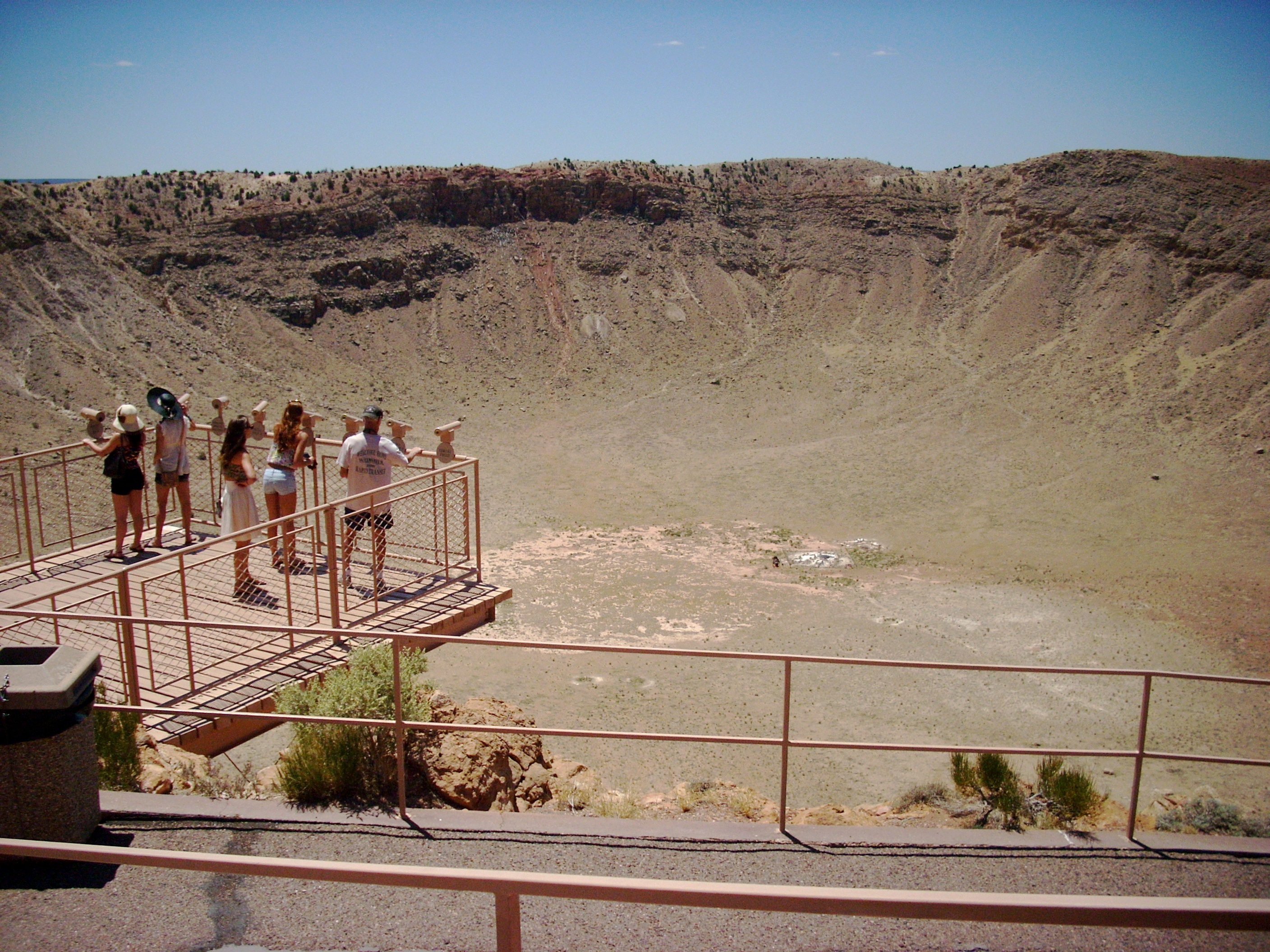 |
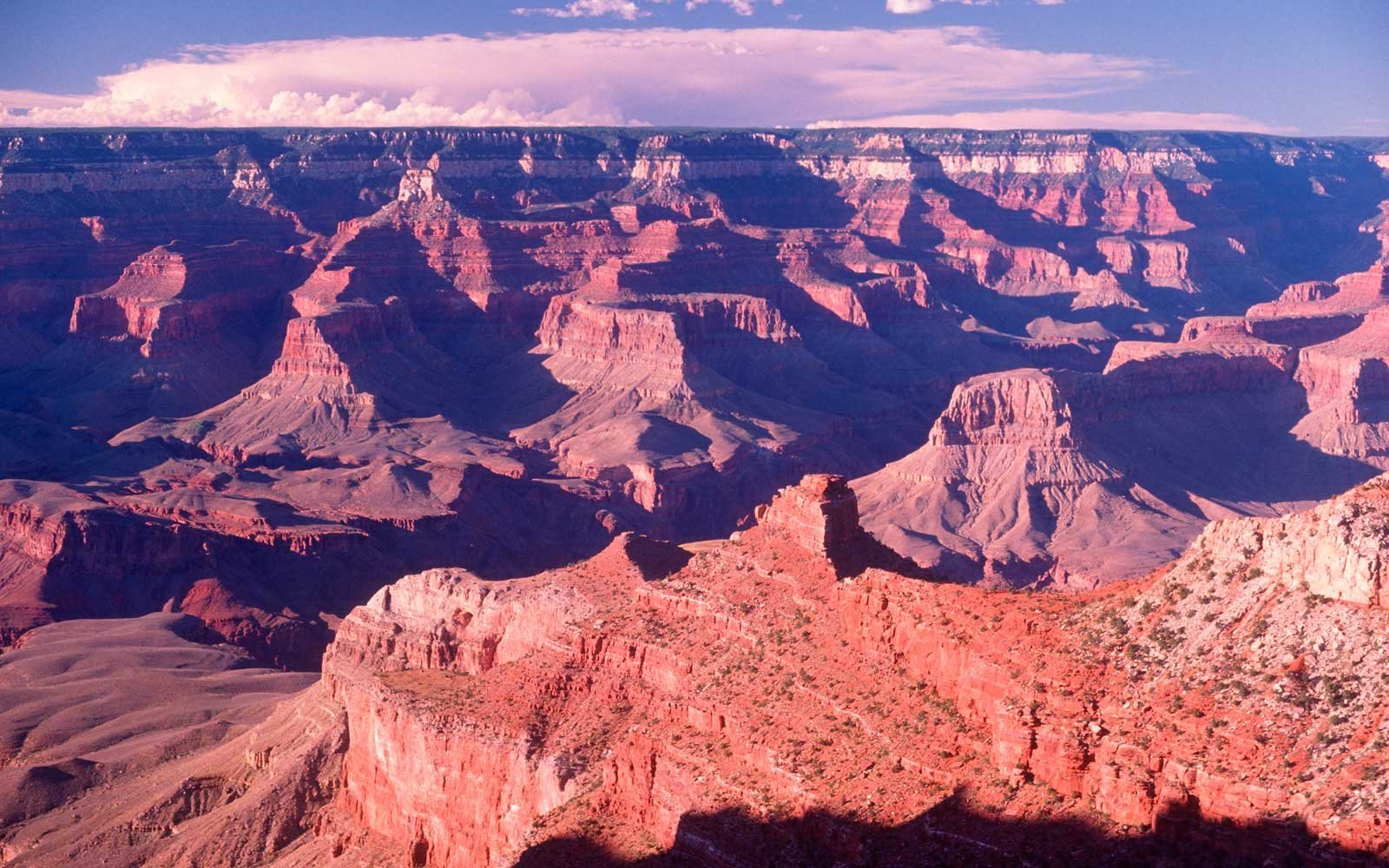 |
If you want to spend a day or a week at the Grand Canyon Flagstaff is the place to get off the train. You should rent a car in advance so it's waiting for you at 8:30 pm when the Chief pulls in. It's about a 30 minute drive to the South Rim and one of the lodges there. We recommend the Maswick Lodge, a quarter mile walk from the edge, with its own parking and cafeteria. If you wnt to eat in Flagstaff before driving to the Canyon we recommend Salsa Bravo, on the eastern edge of town, at 2220 Route 66. Salsa Brava makes everything in house, uses only cholesterol free canola oil, and never uses MSG or lard. They're famous for their Salsa Bar, an extensive array of salsas ranging from mild to hot. The best flavors are Pineapple Habanero Salsa and Tomatillo Salsa, both from the medium category. Other signature items are the Navajo Fry Bread, Smoked Chicken and Carnita Tacos. They have more seafood entrees than any other Mexican restaurant on Route 66. The Sopapillas are an extremely popular item with most regulars. |
Northwestern Arizona offers some of the most spectacular scenery in the nation, but unfortunately the Chief passes through it in the dark whether it's heading westward or eastward. You'll wake up around Fullerton, California and it will be time to eat breakfast and pack up as you approach L.A. If the Chief is on time you'll pull into the station at 8 a.m., so you'll be eating a very early breakfast. You'll pull into the L.A. station underground, but the aboveground outside is one of the more attractive stations in the country.
|
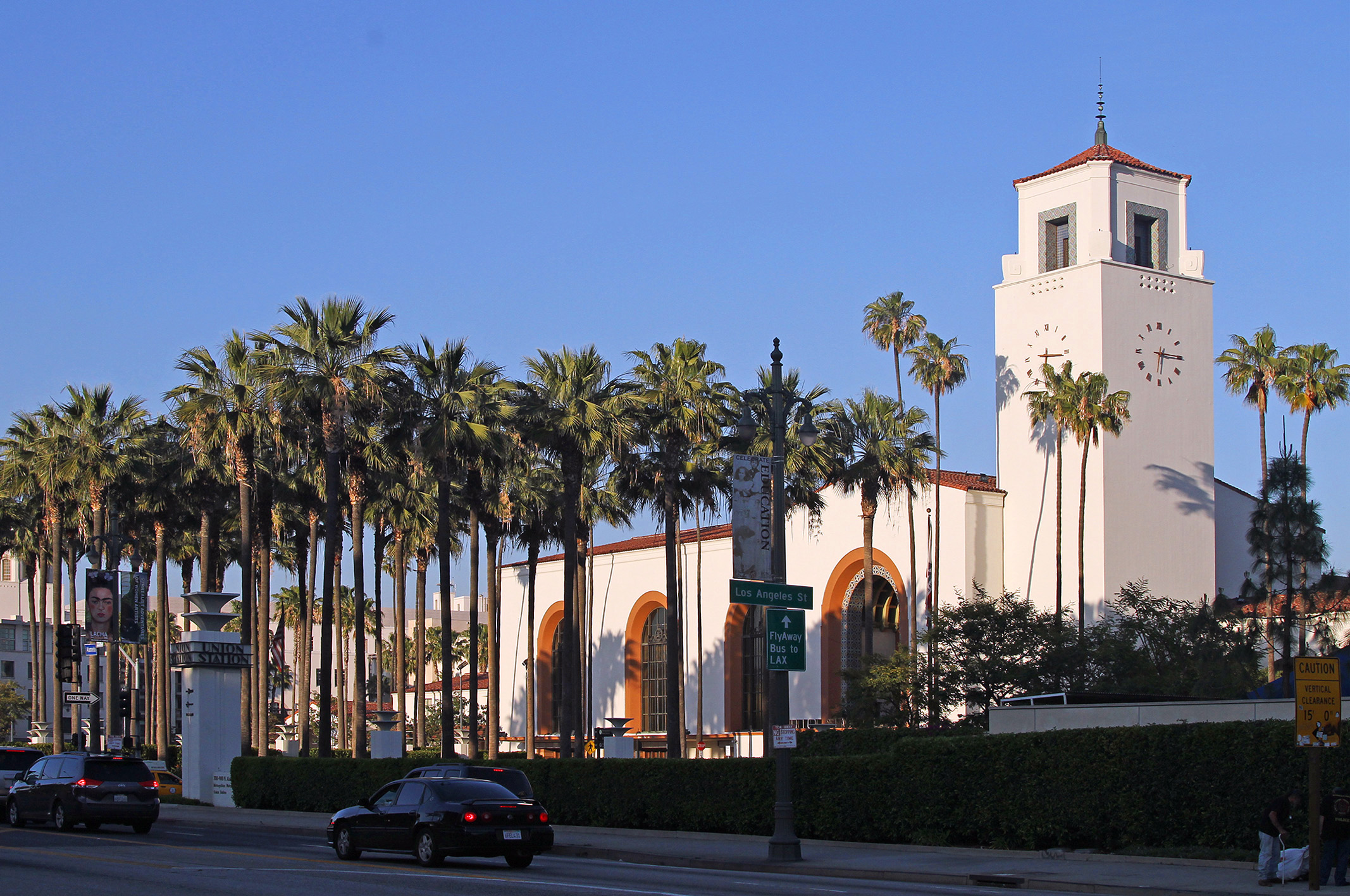 |
|
|||
|